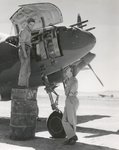cheddar cheese
Major General
FLYBOYJ said:wmaxt said:There is NO reference anywhere that YIPPEE was "Hopped up". The plane Tony LeVier used in the ETO for exhibitions was available off the line there. There is no reason to belive the red plane was different. The aircraft Mattern used for the same purposes was also picked out of delivered aircraft supplies. wmaxt
I believe you are quite correct. After Tony LeVeir retired he ran an aviation safety consulting company out of the old Burbank Facilities, my ex-wife worked close to his office. Back then I did some part-time freelance writing for a local aviation newspaper called Aerotech News and Review. I interviewed LeVeir on two occasions and remember him taking about "YIPPEE." It was stock and he, "Fish" Salmon and Milo Burcham all flew that aircraft around at one time or another. I remember him telling me that only thing special about "YIPPEE" was the paint.
Everything I have read so for back up these statements. Does anyone know the planes exact serial number?





